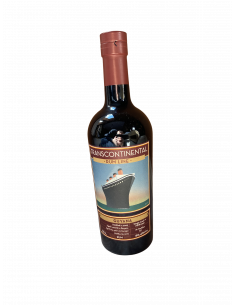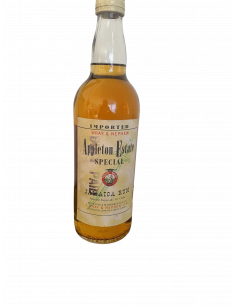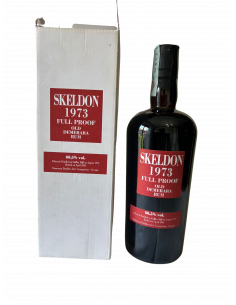Rum
All about Rum
Rum is another type of alcohol that you can find on our platform cabinet7 and that has been around for centuries. It is made from sugarcane byproducts such as molasses and sugarcane juice. It is then distilled and aged in barrels for a period of time. It is often used as an ingredient in a variety of cocktails and mixed drinks, as well as being consumed on its own. Rum has been a part of many cultures for centuries. It has been produced in a variety of countries and regions, each of which has its own unique twist on the drink.
You can find more about the production process of rum and also the history of rum below. Of course, we are also looking into old rum and how you can determine the value of your rare bottle of rum. With the technology we developed at Cognac Expert, (the family business), which spun off cabinet7, we now deliver a framework for the best condition to buy and sell spirits - including Rum.
Why is Rum is often associated with the Caribbean? You can already guess the answer: it's also part of the history of rum section. Nowadays, it is also produced worldwide in countries such as the United States, Canada, and Australia. Due to the worldwide production of rum you will find an incredible variety of different rums, cocktails and unique flavors.
Actually, Cognac Expert has developed a rum aged in Cognac and Pineau-des-Charentes barrels. This is also an example of an experiment that dares to merge both the Rum and Cognac worlds.
But let us focus on your rare and old bottle of rum that you want to keep, drink or sell.
Should I drink or sell the old Rum bottle I inherited?
Well, that’s always a good question and a question that we often get asked by our clients. Whether or not to drink or sell the old rum bottle you inherited is a personal decision and ultimately depends on a few factors. If the rum is of a collectible or historic value, it may be worth more if you sell it. However, if the rum is of a more generic or recent vintage and is still in good condition, it may be worth more if you drink it. If the rum is of no particular value or you are unable to determine its value, it may be best to drink it. Ultimately, it is up to you to decide what is best for you and your rum.
In addition to the potential monetary value of an old rum bottle, there is also great personal value to be found in it. Drinking or selling the bottle can be a way to honor your ancestor and keep their memory alive. It can also be a way to celebrate the importance of their legacy, as well as the history of rum itself. Enjoying an old bottle of rum can be a unique and special experience, as it allows you to travel back in time and experience the same flavors that your ancestor may have enjoyed.
Of course, the sentimental value of such a bottle is sometimes higher than the monetary value - so it may also be worth keeping an old rum bottle.
What is the best way to sell an old Rum bottle?
Actually, there are different ways to sell a rare Rum bottle, such as selling an old Rum bottle on an online marketplace (like cabinet7). You can also try selling it to a local antiques store or consignment shop. You can also try posting it in an online auction house or contacting a collector who specializes in vintage rum bottles. Let us look into the different options a little bit more detailed:
Sell at an auction house: Auctions are a great way to get the highest price for your old Rum bottle. You can find local auction houses that specialize in antiques and collectibles, or you can list it in an online auction house such as LiveAuctioneers or Invaluable.
Sell old rum online on a platform like (cabinet7): cabinet 7 is an online marketplace specifically for antique and vintage bottles. You can list your old Rum bottle on cabinet7 and potentially get a wide range of buyers from around the world.
Sell to a dealer or collector locally: Contacting local dealers who specialize in vintage bottles or collectors who are interested in your item can be another good option. You can also attend local markets and flea markets to find someone interested in your item.
How can I find out what the value of an old rum bottle is?
Finding out the value of an old rum bottle can always be a challenge, as there are numerous factors that can influence the price. The age of the bottle is important, as it can indicate the scarcity and rarity of the item, with older bottles often commanding higher prices. The condition of the bottle is another factor, with chips, cracks, and other damage reducing the value. Furthermore, the brand of the rum and the type of bottle can influence the price.
The best way to get an accurate estimate of the value of an old rum bottle is to take it to an antique dealer or appraiser who specializes in antique bottles. They will be able to evaluate the bottle and provide an educated estimate of its worth. Alternatively, you could also research online to find examples of similar bottles and get an idea of the average price for that type of bottle and check online auction sites to see if any similar bottles have been sold recently.
Determine the value of your old Rum bottle here.
We have gathered submissions since 2009 via Cognac-Expert.com and then expanded our database of sales points in the past years. For evaluating your bottle we first look at past sales of comparable items to get the actual market value for your old bottle of rum.
Checklist of how to analyze the condition of an old Rum bottle
- Examine your bottle: Carefully inspect the bottle for any signs of damage such as cracks, chips, or discoloration. Make sure the bottle is properly sealed and that the cork is in good condition. Additionally, look at the label to see if it is in good condition and all the information is still legible.
- Check the level of the rum: Carefully hold the bottle up against the light and look at the level of the rum. If the rum has gone down significantly, this may indicate that it has been opened and resealed multiple times.
- Look at the color of the rum: Check to see if the rum is still its original color or if it has been darkened over time. The color of the rum can be an indication of its age and quality.
- Smell the rum: Carefully smell the rum to see if there is any off-putting odors or smells. The rum should still have its original aroma, if not, it may have been stored improperly.
- Taste the rum: If possible, taste the rum to see if it has any off-flavors or if it tastes like its original flavor. This can help indicate if the rum has been stored improperly or if it has been aged too long.
The process of analyzing the condition of an old rum bottle is complex. The steps outlined above provide an effective way to evaluate the condition of your old rum bottle. By carefully examining and analyzing the bottle, level, color, aroma, and taste of the rum, you can get an accurate assessment of the quality and age of the rum.
History of Rum
To explore the history of rum, we have to go way back. The history of rum begins in the early 1600s, when alcohol distillation was first introduced to the Caribbean. Yes we know, that's a long time ago. Back then, the spirit was used as a form of currency and as a way to preserve the abundance of sugar cane in the area. Over time, it evolved into a popular beverage, with the British Royal Navy giving its sailors a daily ration of “rum grog” beginning in the 1700s. By the way, did you ever tasted grog?
By the 1800s, rum had become a major industry in the Caribbean, with the majority of production coming from the British colonies of Barbados, Jamaica, Trinidad, and Guyana. During this time, rum was used as the base for many popular cocktails that you are sure to recognize today, including the Daiquiri, the Mojito, and the Piña Colada. And we are sure that you could easily expand this list of rum cocktails.
In the early 1900s, rum production began to shift to the United States, as the temperance movement led to the closure of many Caribbean distilleries. Today, rum continues to be a popular spirit, with numerous styles and varieties available. We do like these different styles of rum.
Below we have gathered a detailed overview of the history of rum. Pretty interesting to see the development over time.
c. 1400s: Rum is first produced in the Caribbean Islands by distilling sugar cane juice.
1520s: Spanish explorer Francisco de Garay discovers Jamaica and introduces sugar cane to the island.
1650s: Barbados becomes the first British colony to produce rum commercially.
1651: Massachusetts Bay Colony becomes the first British colony to issue a rum tax.
1700s: Rum-making has become an important part of the colonial economy in the Caribbean, and rum is a popular drink in the American colonies.
1731: The first recorded advertisement for rum appears in the Boston Gazette.
1750s: Rum is the preferred drink of the British Royal Navy and is used to pay seamen’s wages.
1764: Excise taxes are imposed on rum in the American colonies.
1775-1783: Rum is used as a medium of exchange in the American Revolution.
1780s: Jamaica becomes the largest producer of rum in the world.
1790s: Rum becomes an important part of the slave trade in the Caribbean.
1808: The British abolish the slave trade.
1820s: Rum production in the Caribbean begins to decline due to the rise of sugar beet production in Europe.
1850s: Rum production in the Caribbean begins to rise again as the popularity of the spirit increases in the United States.
1860s: Rum is used to sweeten Coca-Cola, which is sold in pharmacies as a “brain tonic.”
1870s: The golden age of rum begins in the Caribbean as the demand for rum increases in the United States.
1890s: Rum-based cocktails become popular in the United States, and the first rum-based liqueur, Bacardi, is introduced.
1920s: Prohibition in the United States leads to a decline in rum production in the Caribbean.
1933: The repeal of Prohibition leads to a resurgence in rum production in the Caribbean.
1940s: Rum-based cocktails become popular in the United States, and the popularity of rum continues to grow.
1960s: Rum becomes a popular spirit in the United States and is used to make a variety of cocktails.
1970s: The popularity of rum-based cocktails continues to increase in the United States.
1980s: Flavored rums become popular in the United States, and the popularity of rum-based cocktails continues to grow.
1990s: Rum is used to make a variety of flavored liqueurs and is used in a variety of cocktail recipes.
2000s: Rum continues to be popular in the United States and is used to make a variety of new and innovative cocktails.
2010s: Artisanal and craft rums, as well as flavored rums, become increasingly popular in the United States.
2020s: Rum continues to be popular in the United States and is used to make a variety of cocktails.
The process of making rum
Rum is a distilled alcoholic beverage made from sugarcane or molasses. It has a long and varied history (as you know from our short digression above), with its origins dating back to the 1700s in the Caribbean. Rum is now enjoyed all over the world, with each region having its own unique take on the spirit.
In short, here's the process of making Rum:
- Ferment the base material – typically sugarcane juice or molasses
- Distill the fermented liquid
- Age the distillate in various types of casks
- Filter the rum to remove impurities
- Bottle and ship the rum to the consumer
And now, let's look into the processes a bit more detailed:
The process of making rum starts with fermenting the base material, usually either sugarcane juice or molasses. This is done by adding yeast and allowing the mixture to ferment for several days. This process creates the alcoholic base of the rum.
Once the mixture has fermented, it is distilled. Distillation is the process of heating the fermented liquid to separate the alcohol from the solids. The resulting liquid is known as the distillate.
The distillate is then aged. Rum can be aged in various types of casks, from oak barrels to stainless steel tanks. The length of time it is aged can vary from a few months to several years, depending on the desired flavor.
Once it has been aged, the rum is filtered. This is done to remove any impurities that may have been left behind during the distillation process.
Finally, the rum is bottled and shipped to the consumer - that could be you if you find an old bottle of rum on our platform. This is the last step in the process of making rum.
Though the process of making rum is quite complex, it is the result of the hard work and dedication of the distillers that makes it so enjoyable. With each passing year, new styles and flavors of rum are created, offering something unique and special for everyone to enjoy.
Old Monk Rum bottles can be opened using a standard bottle opener. Simply insert the opener into the top of the bottle and press down to pry the cap off. If the bottle is sealed with a metal cap and a wax seal, use a sharp knife to carefully cut the wax seal around the cap and then use the bottle opener to open the cap.
Yes, rum is a spirit. Rum is a distilled alcoholic beverage made from sugarcane by-products, such as molasses or syrup, by a process of fermentation and distillation. It is typically aged in oak barrels or casks (it's the same for Cognac or Whisky), which gives it its distinctive flavor and color.
Yes, rum is a distilled spirit.
No, rum is not the oldest spirit in the world. The oldest spirit in the world is believed to be a distilled beverage known as arak, which is believed to have originated in the Middle East over 4,000 years ago.
Rum is believed to have originated in the Caribbean in the 17th century, and is believed to have been derived from an earlier drink made from sugar cane known as “Kill Devil.” While the exact date of the first production of rum is unknown, it is thought that rum first appeared around the mid-1600s.
You can buy old and rare rum on our platform cabinet7 which is an online platform that offers a wide selection of spirits, including old rum, from around the world. You can also find exclusive deals cabinet7, making it perfect for finding the perfect rum for your collection.





